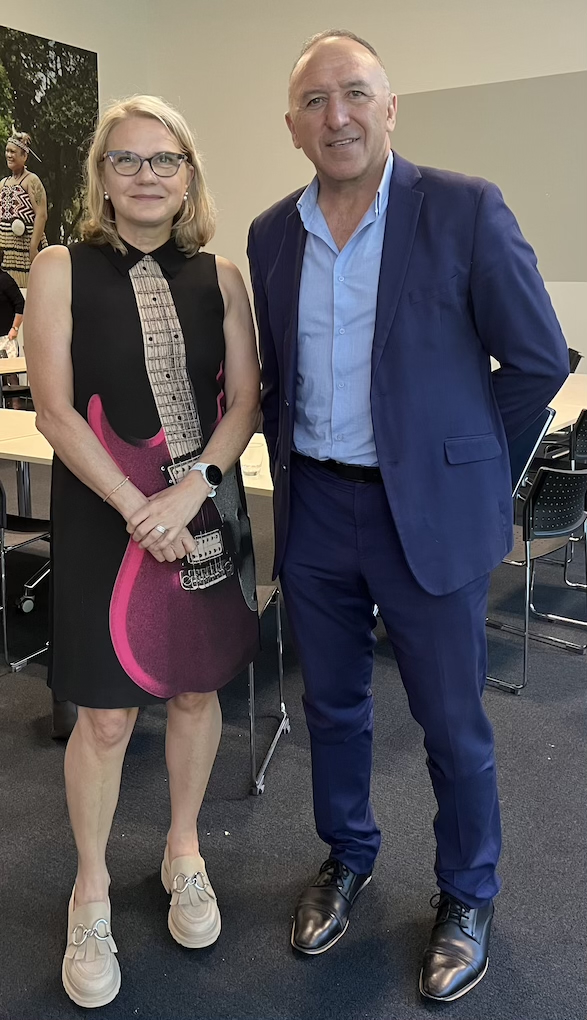Waitangi Day is coming up and if it’s anything like the hui-ā-motu hosted by the Kiingitanga, many people will be in attendance.
Re: News spoke to the Chairman of the Waitangi National Trust Pita Tipene (Ngāti Hine) about what Waitangi Day is like and what to expect this year.

Pita Tipene (right) with Chief Justice - Helen Winkelmann. Photo: Supplied
For someone who has never been to Waitangi - can you explain what it's about and what happens there, and the formalities?
First of all, I think everybody understands that Waitangi was the first place where Te Tiriti o Waitangi was signed, on the 6th of February, 1840.
When people come here, they sense the environment that they are coming into. It's a beautiful environment, it's overlooking Te Moana Pikopiko-i-Whiti. That's the inner Bay of Islands.
What strikes people is the wairua of the place, and just feeling the mauri and the mana and the persona, because it is the place where Papatūānuku (earth) and Ranginui (sky) are people.
And then people come into Ruarangi, which is the actual flat area where the flagstaff is and where James Busby’s house is, otherwise called the Treaty house.
That is all around the actual whenua where the Treaty of Waitangi, Te Tiriti o Waitangi was signed.
There is also the whare maumahara or the museum to remember all of the Māori return service people who fought for their country.
Ultimately, it is the sacred ground where Te Tiriti o Waitangi was signed. And is the birthplace of the nation, that is what people will feel.
Can anyone attend?
Any of the Treaty grounds are open to the public.
What is the purpose of Waitangi day?
The purpose of Waitangi Day is to remember the signing of the Tiriti o Waitangi and the promise of Waitangi because our ancestors who signed Te Tiriti were putting their mark and their mark was very, very sacred.
How would you describe the relationship between the Crown and mana whenua/tangata whenua at Waitangi?
The relationship is strained at the moment. It's really strained and it's because of the messages that are coming out of the coalition Government.
People need to have conversations. And there's a lot of frustration. There's a lot of anger and it's all directed at the politicians who are leading what people consider to be an attack on Te Tiriti o Waitangi.
Would you say in the past when te iwi Māori attended Waitangi day they were united?
Yes, we do come united. Hapū and iwi come together and we want Te Tiriti to be honoured.
Our people have a range of ways of showing their anger and frustration, what we like to say here at Waitangi is, to express yourself but do so in a respectful way and in a way that doesn't tread on the mana of others.
But this is the place to come and express your anger and frustration.
What will be different about this Waitangi Day compared to recent years?
Over the many many years that I’ve been coming to Waitangi, there has always been protest.
There's always been anger and frustration.
And when you look at what happened on the 6th of February 1840 itself, it happened on the very day that it was signed. So it's always been a cauldron of that anger and frustration.
But I think this year will be heightened given what the Government is proposing.
What impact has the Hui-ā-Motu had in the build-up to Waitangi Day?
I really thank and acknowledge the Kiingitanga and Kiingi Tuuheitia.
I think the people wanted a forum in which to express themselves in a way that Māori could talk with Māori and make sure that we are moulding cohesive and clear togetherness, kotahitanga in the lead-up to both Rātana and to Waitangi.
I think it was well-timed.
What are the outcomes that you want from this year’s Waitangi Day?
The ultimate outcome that I want is for Te Tiriti and He Whakaputanga (a Declaration of Independence that was signed on October 28, 1835) to be honoured and the promise that our ancestors put to that parchment will be honoured.
And that it will be reflected in how this country is run - not how it's run now.
Image: Waitangi Day in 2021. Photo by Fiona Goodall/Getty Images
More stories:
Is it appropriate for non-Māori to have a moko?
Ringa moko (Māori tattoo artist) Cody Hollis explains.
What it's like moving back in with your parents after university
A loss of independence for some, a respite for others.
The indigenous bond between Māori and Native Americans
“We’re proud and we’re here today because of the resilience our ancestors instilled in us.”